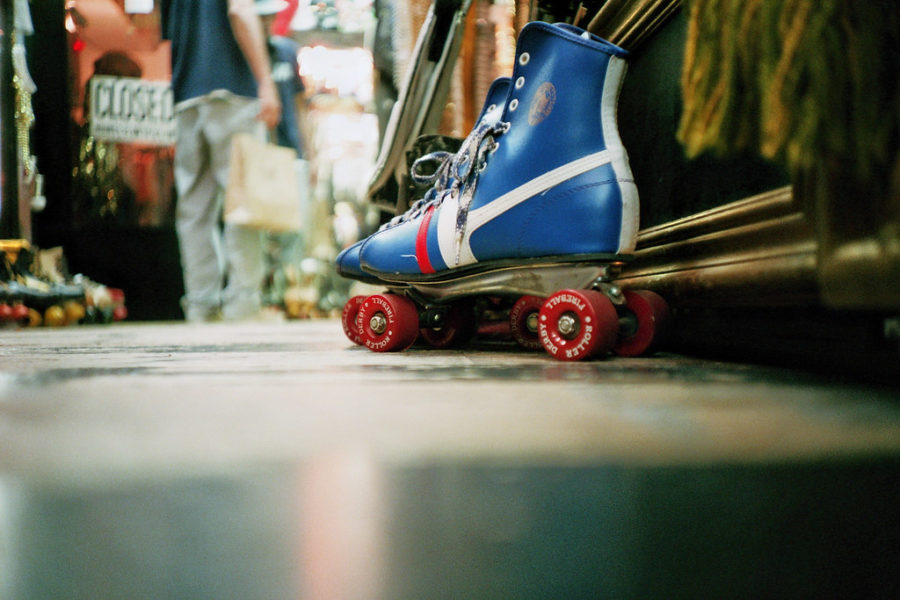How to rock at roller skating
Here are some steps you can take to improve your roller skating skills
Boredom – the bane of human existence. It’s an issue that has yet to become lost on the human race and so time and time again we are searching for new engaging activities. With that, it’s understandable why many found the COVID-19 quarantine to be a good time to develop new skills and pick up new hobbies, one new hobby being roller skating.
For those who have just recently gotten an inkling they’d like to roller skate or those who have already bought a pair of skates that want to better their skating, here are some steps to learn how to roller skate.
Step one: Buy a pair of skates
It seems as if this would be a self explanatory step because you can’t roller skate without, well, roller skates, but for me this was one of the hardest steps. I was hesitant to buy a pair of skates because I feared that I’d spend money on a pair just to realize I wasn’t good at the sport and give up, ultimately leaving those roller skates to crease and collect dust under my bed.
Despite this, it is important to be logical and acknowledge that you will never fully learn how to do something if you do not have access to the proper material and equipment. It also helps to acknowledge that many people find it difficult to commit fully to a hobby. In fact, it is currently believed that the average person commits to a hobby for only 16 months. So, losing interest would not be something shameful or be a step out of the norm.
That being said, buy those skates. When it comes to brands, some of the most popular brands that make roller skates are Impala Skate, Moxi Skates, Roller Derby Roller Skates and Riedell Skates. The size of the roller skates is usually the same as your regular shoe size, like if you are a men’s size 11 in sneakers you are most likely a men’s size 11 when you buy roller skates. You can choose any design for the skates, it makes no true difference.
Step two: Consider buying additional gears
Again, this seems like a no brainer but roller skating is actually a sport with high injury rates. An article from the National Library of Medicine states that in roller skating, around 86% of injuries related to the sport were serious injuries and that 28% of those serious injuries were bad enough to cause the need for surgery. This means that injury is not uncommon in roller skating and so it may be in your best interest to buy protective gears. This includes things like a helmet, knee pads and wrist guards. More likely than not the retailer you buy the actual skates from will also have a plethora of protective gear to choose from.
Step three: Learn the correct posture
After buying all the necessary gear, it is time to get into the actual action-based and physical requirements of roller skating. The first thing to consider is that your feet should be equally shoulder width apart. With that your knees should be slightly bent and you should be almost in a squatting position.
It is good to have a slight lean forward and keep the core muscles tight and engaged. A big mistake people make when starting to roller skate is developing a false sense of security that if they lock their knees and keep their back straight they are unlikely to fall, but this is not true. This sport requires more fluidity and particular weight distribution to prevent falling and the complete loss of balance.
Step four: Do some warmups and preparation
Walking like a duck, standing on one foot and purposely making yourself fall all sounds incredibly silly to do, however, these warmups assist in training your balance and build endurance to meet the demanding leg strength that goes into being able to roller skate.
To duck walk, you would put your heels together and point your toes out to then slowly walk forward, right to left, right to left. When standing on one foot, remain in the aforementioned roller skating position and practice shifting weight on the different feet by picking up one foot and balancing on the other.
Struggle with balance doesn’t mean you will never be able to learn how to roller skate, it just means you will need more practice gaining more solid footing. As for making yourself fall, it seems like a crazy idea to purposely fall, but doing so will better train your response to when you find yourself about to fall involuntarily. In making yourself fall, stand in your skates and make yourself small by squatting more and increasing that lean forward just slightly and prepare to land on either your buttocks or knees, while wearing knee pads, and avoid bracing yourself primarily with your arms-this prevents wrist fractures, a common injury.
In general, allow yourself a quick moment to stretch out your legs and alleviate lower limb tension.
Step five: Learn how to stop
The final thing you will want to do before getting into the actual skating part is learn how to stop. This can be done by lifting your back leg and using the rubber protruding part called the toe stop by dragging it on the ground behind you. If wearing knee pads you can lower one knee to the ground and allow it to drag and if that doesn’t work out for you, you can also point your toes inward to each other to slow you down to get into a stop.
Step six: Now skate
Now it is time for the big guns and the move into intermediate and possibly unfamiliar territory-it is now time to skate. Reassume the skating position and stand on your dominant leg and do a small push with your other leg so you could start rolling forward. Push side to side with your legs and glide. To gain momentum put pressure on the wheels and thrust yourself forward. To move in a certain direction (left or right) move your body to a slight lean in the desired direction while remaining in the squatting position. Continue the motions of pushing and gliding-that’s the motion of skating.
General tips:
- When wearing your roller skates, it is best to wear long socks to prevent painful blisters.
- Do not stiffen up or lock your knees-this was mentioned earlier but this is an important point to remember.
- Stay hydrated because this is an activity that burns a lot of calories, so hydration is a must.
- It’s good to practice in wide-open areas. Things like tennis courts, driveways and empty parking structures are a good start.
- Don’t be too nervous to fall or overthink your movement. It is incredibly rare to become a prodigy or expert at a hobby you recently just picked up, so do not feel pressured to be the best when you are just beginning to skate.
- Listening to music is great at enriching the roller skating experience, so maybe consider compiling a music playlist of your own to listen to while you practice or skate around.
- What they say is right – practice makes perfect. Don’t be so quick to doubt your ability to ever learn how to skate or be so harsh as to feel embarrassed about your interest in the sport.
If you are ready to start skating, here are some retailers that sell roller skates and skating gear that were not previously listed: Dick’s Sporting Goods, Zumiez, Tillys and C7skates.



